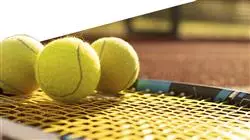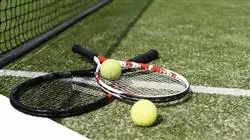University certificate
The world's largest faculty of sports science”
Introduction to the Program
Specialize with TECH Global University in High-Performance and Competitive Tennis with the most innovative and accessible teaching from any digital device with internet connection”

The goal of every tennis player is to be one of the great players of Grand Slam, Masters 1000, Premier Mandatory or Premier 5. A goal that requires constant work, hand in hand with a first class coaching staff. For this reason, it is necessary that the coach has not only a deep knowledge of the sport, but also includes the latest technological advances for game analysis, performance or advances in the improvement of the hitting technique.
So, behind figures like Serena Williams, Rafa Nadal, Federer or Djokovic there is a preparation from childhood that is perfected in High Performance. To boost the professional career of those who want to be the next coaches or physical trainers, TECH Global University has developed this 24-month university degree with the most advanced syllabus in High-Performance and Competitive Tennis.
A program that will lead the graduate to obtain an exhaustive learning on the study of biomechanics, the improvement of the tennis serve and stroke, the improvement of the movement on the court or the physical preparation and planning, taking into account the moment of competition. Also, this academic option includes the most advanced technology to be able to carry out technical-tactical studies of both the athlete and the opponent.
All this, in addition to a pedagogical material based on video summaries of each topic, videos in detail, specialized readings and case studies that provide a theoretical-practical and dynamic perspective. Likewise, the Relearning system, based on content reiteration, students will be able to reduce the long hours of study and easily consolidate the most important concepts.
A program that is also known for its flexibility and convenience. The future technician will only need a digital device with internet connection, which will allow him/her to view the program at any time of the day. So, with no classroom attendance or scheduled classes, the graduate will be able to reconcile his or her daily activities with quality education.
Incorporate into your training planning, proper nutrition, as well as the necessary supplementation for each athlete and time of the season”
This Advanced master’s degree in High-Performance and Competitive Tennis contains the most complete and up-to-date scientific program on the market. The most important features include:
- The development of practical cases presented by experts in Tennis, Physical Activity and Sport Sciences, Nutrition and Psychology
- The graphic, schematic and eminently practical contents with which they are conceived gather scientific and practical information on those disciplines that are essential for professional practice
- The practical exercises where the self-evaluation process can be carried out to improve learning
- Its special emphasis on innovative methodologies in the direction, management and training of professional volleyball teams
- Theoretical lessons, questions to the expert, debate forums on controversial topics, and individual reflection assignments
- Content that is accessible from any fixed or portable device with an Internet connection
A study plan that will lead you to increase your training level and incorporate the most effective work methodology in High Performance Tennis”
It includes in its teaching staff professionals belonging to the Volleyball field who pour into this program the experience of their work, in addition to recognized specialists of renowned societies and prestigious universities.
The multimedia content, developed with the latest educational technology, will provide the professional with situated and contextual learning, i.e., a simulated environment that will provide an immersive learning experience designed to prepare for real-life situations.
This program is designed around Problem-Based Learning, whereby the student must try to solve the different professional practice situations that arise throughout the program. For this purpose, the professional will be assisted by an innovative interactive video system created by renowned and experienced experts.
TECH Global University has designed a degree compatible with your most demanding responsibilities, without neglecting the quality of its content"

Work on the tactics and the best strategy of the Tennis player's game through an intensive syllabus with an eminently practical approach"
Why study at TECH?
TECH is the world’s largest online university. With an impressive catalog of more than 14,000 university programs available in 11 languages, it is positioned as a leader in employability, with a 99% job placement rate. In addition, it relies on an enormous faculty of more than 6,000 professors of the highest international renown.

Study at the world's largest online university and guarantee your professional success. The future starts at TECH”
The world’s best online university according to FORBES
The prestigious Forbes magazine, specialized in business and finance, has highlighted TECH as “the world's best online university” This is what they have recently stated in an article in their digital edition in which they echo the success story of this institution, “thanks to the academic offer it provides, the selection of its teaching staff, and an innovative learning method aimed at educating the professionals of the future”
A revolutionary study method, a cutting-edge faculty and a practical focus: the key to TECH's success.
The most complete study plans on the university scene
TECH offers the most complete study plans on the university scene, with syllabuses that cover fundamental concepts and, at the same time, the main scientific advances in their specific scientific areas. In addition, these programs are continuously being updated to guarantee students the academic vanguard and the most in-demand professional skills. In this way, the university's qualifications provide its graduates with a significant advantage to propel their careers to success.
TECH offers the most comprehensive and intensive study plans on the current university scene.
A world-class teaching staff
TECH's teaching staff is made up of more than 6,000 professors with the highest international recognition. Professors, researchers and top executives of multinational companies, including Isaiah Covington, performance coach of the Boston Celtics; Magda Romanska, principal investigator at Harvard MetaLAB; Ignacio Wistumba, chairman of the department of translational molecular pathology at MD Anderson Cancer Center; and D.W. Pine, creative director of TIME magazine, among others.
Internationally renowned experts, specialized in different branches of Health, Technology, Communication and Business, form part of the TECH faculty.
A unique learning method
TECH is the first university to use Relearning in all its programs. It is the best online learning methodology, accredited with international teaching quality certifications, provided by prestigious educational agencies. In addition, this disruptive educational model is complemented with the “Case Method”, thereby setting up a unique online teaching strategy. Innovative teaching resources are also implemented, including detailed videos, infographics and interactive summaries.
TECH combines Relearning and the Case Method in all its university programs to guarantee excellent theoretical and practical learning, studying whenever and wherever you want.
The world's largest online university
TECH is the world’s largest online university. We are the largest educational institution, with the best and widest online educational catalog, one hundred percent online and covering the vast majority of areas of knowledge. We offer a large selection of our own degrees and accredited online undergraduate and postgraduate degrees. In total, more than 14,000 university degrees, in eleven different languages, make us the largest educational largest in the world.
TECH has the world's most extensive catalog of academic and official programs, available in more than 11 languages.
Google Premier Partner
The American technology giant has awarded TECH the Google Google Premier Partner badge. This award, which is only available to 3% of the world's companies, highlights the efficient, flexible and tailored experience that this university provides to students. The recognition as a Google Premier Partner not only accredits the maximum rigor, performance and investment in TECH's digital infrastructures, but also places this university as one of the world's leading technology companies.
Google has positioned TECH in the top 3% of the world's most important technology companies by awarding it its Google Premier Partner badge.
The official online university of the NBA
TECH is the official online university of the NBA. Thanks to our agreement with the biggest league in basketball, we offer our students exclusive university programs, as well as a wide variety of educational resources focused on the business of the league and other areas of the sports industry. Each program is made up of a uniquely designed syllabus and features exceptional guest hosts: professionals with a distinguished sports background who will offer their expertise on the most relevant topics.
TECH has been selected by the NBA, the world's top basketball league, as its official online university.
The top-rated university by its students
Students have positioned TECH as the world's top-rated university on the main review websites, with a highest rating of 4.9 out of 5, obtained from more than 1,000 reviews. These results consolidate TECH as the benchmark university institution at an international level, reflecting the excellence and positive impact of its educational model.” reflecting the excellence and positive impact of its educational model.”
TECH is the world’s top-rated university by its students.
Leaders in employability
TECH has managed to become the leading university in employability. 99% of its students obtain jobs in the academic field they have studied, within one year of completing any of the university's programs. A similar number achieve immediate career enhancement. All this thanks to a study methodology that bases its effectiveness on the acquisition of practical skills, which are absolutely necessary for professional development.
99% of TECH graduates find a job within a year of completing their studies.
Advanced Master's Degree in High-Performance and Competitive Tennis
High-performance and competitive tennis is a discipline that requires a deep technical, tactical, physical and mental knowledge to reach the highest level of excellence. At TECH Global University, we understand the importance of specialized training in this sport, which is why we have developed our Advanced Master's Degree in High-Performance and Competitive Tennis. In this postgraduate program, essential topics for the professional tennis player will be addressed, such as training planning and periodization, physical preparation and injury prevention, tactics and game strategies, and sports psychology applied to tennis. In addition, the technical and tactical analysis of players and matches, as well as the management of the professional tennis player's career, will be covered in depth.
The Advanced Master's Degree in High-Performance and Competitive Tennis aims to train tennis professionals in the latest trends and approaches to high performance in this sport. Through a practical and up-to-date approach, participants will acquire the necessary skills to plan and execute specific training, optimize physical preparation and prevent injuries, all in 100% online mode. Make the most of the opportunity and improve your sports career with TECH







